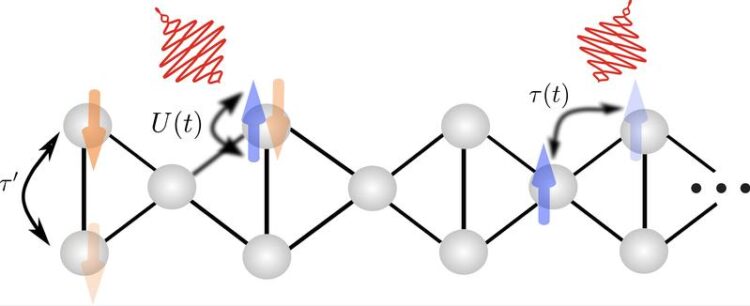Cheering up a frustrated quantum system

Electrons with spin (arrows) on the same lattice site pay an energy price U. When the system is irradiated with a laser pulse and the lattice is shaken, the U becomes time-dependent (U(t)), causing superconducting pairing between the electrons.
Joseph Tindall, University of Oxford
One of the holy-grail questions in condensed matter physics is how superconductivity — the property of many electrons to go into a quantum soup state that can carry electricity without losses — emerges at relatively high temperatures in certain materials, and how these temperatures could be boosted even further. Now a research team at the University of Oxford and the Max Planck Institute for the Structure and Dynamics of Matter in Hamburg is reporting in Physical Review Letters that a dynamical version of superconductivity, which is generated by periodically shaking the material, is intimately tied to strong electronic correlations and geometric frustration.
Geometric frustration is a property of interacting quantum systems with a spin degree of freedom that can be likened to little compass needles. In a so-called antiferromagnet, when these spins are next to each other, they try to point in opposite directions in order to lower their energy — one of them to the north, the other one to the south.
Now suppose that you force a third spin close into a triangle with the other two. How should it orient its spin? If it points north, the first spin will be unhappy; if it points south, the second one will be. This dilemma is called frustration and is at the root of many intriguing properties in quantum materials.
Now a theory team led by Dieter Jaksch at Oxford University and Michael Sentef at the MPSD reveals a new avenue towards exploiting magnetic frustration. When the frustrated material is stimulated by a short laser pulse of the right color, it can become superconducting at temperatures much higher than those at which superconductivity is observed in the same material without laser stimulation. „We were stunned when we first saw this effect in our numerical results“, says Joseph Tindall, a PhD student in Jaksch’s group and lead author of the study.
The idea for the investigation was born out of a collaboration with Andrea Cavalleri’s experimental group at the MPSD, which had reported light-induced superconductivity in a frustrated organic conductor earlier this year. „In our experiment, we observed superconducting behavior at relatively high temperatures when we used a laser at colors which can drive specific lattice vibrations of the crystal“, explains the lead author of the experimental paper and co-author of the theory paper, Michele Buzzi (MPSD). „We then turned to our theory collaborators to help us understand why these particular vibrations were special.“
„We had seen in calculations that certain vibrations allow one to dynamically modulate the interactions — that is, the mutual Coulomb repulsion between electrons — in the organic conductor“, explains Sentef. The numerical simulations performed by Tindall used this piece of information as an input to explore under which circumstances these dynamical interactions could give rise to superconducting behavior. They found, intriguingly, that a certain degree of frustration — just the right amount — helps create the superconducting state by laser stimulation.
„We believe that our results point to a more general mechanism for the dynamical creation of superconductivity“, explains Jaksch. „While our study was motivated by this one experiment in the Cavalleri group, our theoretical and numerical analysis points to the important ingredients for the effect — the combination of frustration, the right color of the laser, and the lattice structure of the underlying material.“ Cavalleri adds: „We hope that these results will help us find commonalities between different materials in which we have already observed light-induced superconductivity in our experiments, and also guide our search for new materials that are worth exploring.“
Wissenschaftliche Ansprechpartner:
Joseph Tindall, lead author: joseph.tindall@physics.ox.ac.uk
Originalpublikation:
https://doi.org/10.1103/PhysRevLett.125.137001
Weitere Informationen:
Media Contact
All latest news from the category: Materials Sciences
Materials management deals with the research, development, manufacturing and processing of raw and industrial materials. Key aspects here are biological and medical issues, which play an increasingly important role in this field.
innovations-report offers in-depth articles related to the development and application of materials and the structure and properties of new materials.
Newest articles
Humans vs Machines—Who’s Better at Recognizing Speech?
Are humans or machines better at recognizing speech? A new study shows that in noisy conditions, current automatic speech recognition (ASR) systems achieve remarkable accuracy and sometimes even surpass human…

Not Lost in Translation: AI Increases Sign Language Recognition Accuracy
Additional data can help differentiate subtle gestures, hand positions, facial expressions The Complexity of Sign Languages Sign languages have been developed by nations around the world to fit the local…

Breaking the Ice: Glacier Melting Alters Arctic Fjord Ecosystems
The regions of the Arctic are particularly vulnerable to climate change. However, there is a lack of comprehensive scientific information about the environmental changes there. Researchers from the Helmholtz Center…



